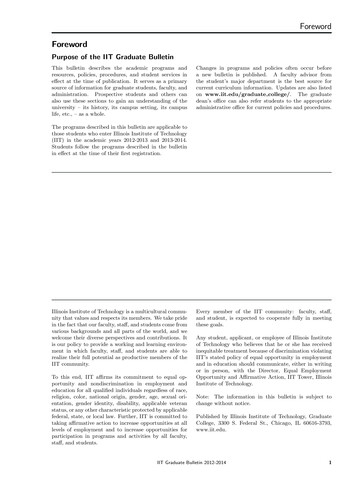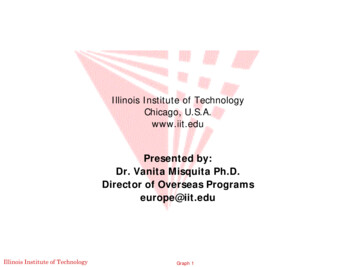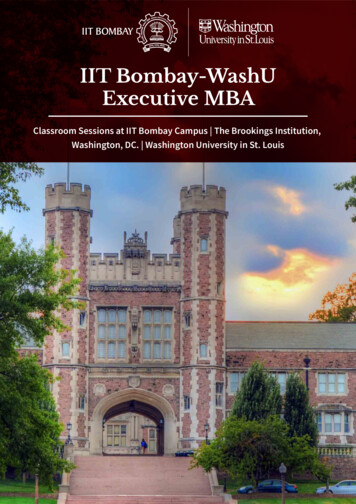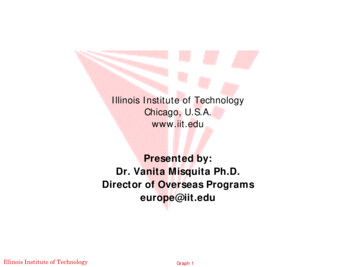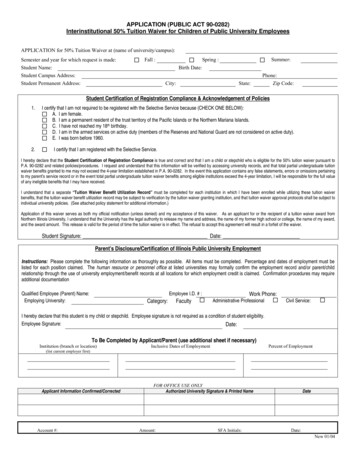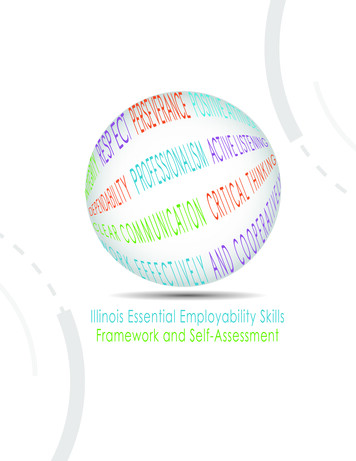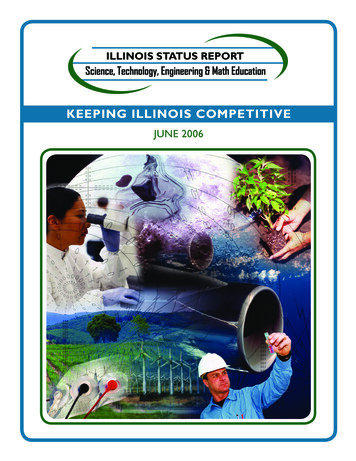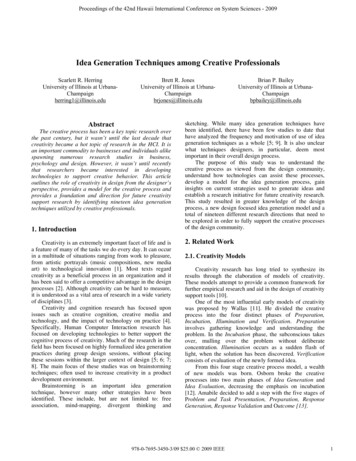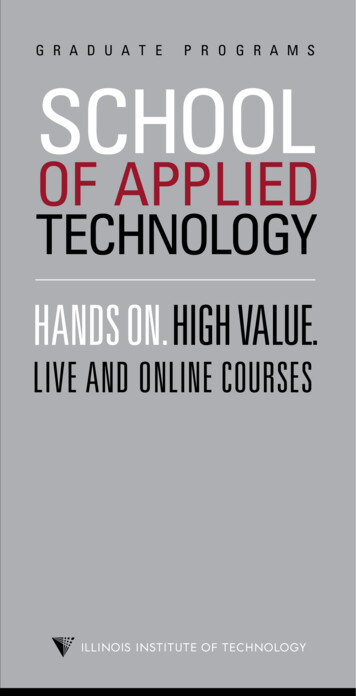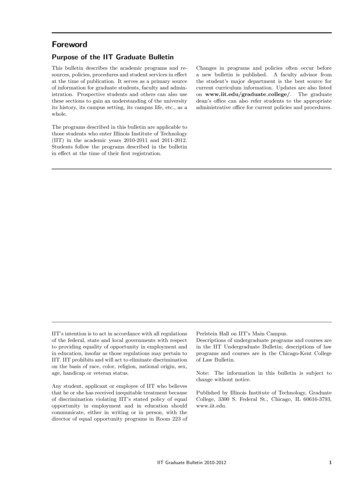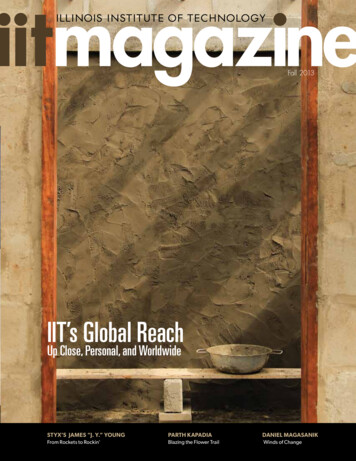
Transcription
Fall 2013IIT’sGlobalReachUp Close, Personal, and WorldwideStyx’s James “J. Y.” YoungParth KapadiaDaniel MagasanikFrom Rockets to Rockin’Blazing the Flower TrailWinds of Change
from the President“I live my life in widening circles that reach out across the world.”—Rainer Maria RilkeI especially look forward to two times of the year on the academic calendar. One is Commencement.I like to remind people that graduation is associated with “commencement” for a good reason. It isthe beginning of “life after IIT” and, if we have done our jobs well, our students start traveling downa road carrying with them the tools they need to be global citizens, contributors to society, andinnovative thinkers.The second time is the beginning of fall semester. I get particular pleasure in welcoming back ourreturning students and getting the chance to know those who are arriving on campus for the first time.This fall, enrollment and retention reached new heights. Retention, defined as the percentage of firstyear students who return for their second year, now stands at 93 percent—the fourth year in a row wehave exceeded 90 percent. Our first-year, full-time undergraduate enrollment is the highest since 1981,and our total enrollment (graduate plus undergraduate) is the highest since 1968.There is a renewed energy and spirit on campus, in part from having more students, but also becauseof the young men and women who have come to IIT from 94 countries. They bring with them newperspectives—and their presence adds to the cultural richness for which our university is known.At this year’s international alumni gathering in Seoul [page 8], I was pleased to report that studentsfrom Asia, Africa, Europe, Central America, South America, as well as the United States and Canada,continue to follow in their footsteps—coming to Chicago and IIT for a world-class education. It was a tripthat reaffirmed for me that the accomplishments of our international alumni have had a significant impacton our ability to attract talented students from around the world.Members of the IIT community are also embarking on projects that extend far beyond our nation’sborders, improving the quality of life in major cities and re-shaping small villages in ways that are bothbeautiful and profound. Our students, faculty, and alumni are working and studying in countries aroundthe world, taking with them the entrepreneurial drive and curiosity for which this university has alwaysbeen known, while bringing home new appreciation for different perspectives and points of view.When I look out from the stage at Commencement in the spring and walk across campus each fall,I remind myself not to take our diversity for granted. It is so much a part of who we are as a university thatit is sometimes easy to forget that its impact on all of us is significant. The diversity of the IIT communityhelps ensure that we will continue to look at our world through a global lens, that we will remember toembrace cultural differences, and that we have a responsibility as citizens to continue to make our worlda better and safer place for the generations that follow.John L. AndersonPresident
iitmagazineVICE PRESIDENT FOR MARKETINGAND COMMUNICATIONSJeanne HartigEDITORMarcia FayeCONTRIBUTORSFall 2013David ChongRichard HarthJeanne HartigColleen HumerChelsea Kalberloh Jackson8ART DIRECTOR/DESIGNNancy Niequist SchoonOn the CoverIIT MAGAZINE IS PUBLISHEDTHREE TIMES A YEARBY THE IIT OFFICE OF MARKETINGAND COMMUNICATIONS.IIT’s Global ReachIIT Magazine is a 2013 recipientof the Publicity Club of ChicagoSilver Trumpet Award for Excellencein Newspapers or Magazines, and a2012 CASE V Silver Medal for BestAlumni Magazine.IIT alumni, students, and faculty 2013in distinctive areas of educationIIT Magazine is printed onSFI certified recycled paper.Read it, share it, recycle it.and research.”SEND LETTERS TOIIT MagazinePHOTOS: Frank FluryOffice of Marketingand Communications10 West 35th Street, Suite 4D7-1Chicago, IL 60616OR EMAIL iitmagazine@iit.eduSEND ALUMNI NEWS TOalumni@iit.eduFounded in 1890, Illinois Instituteof Technology is a private, Ph.D.granting research university thatawards degrees in engineering, thesciences, architecture, law, design,psychology, humanities, appliedscience, and business.IIT MISSION STATEMENTTo provide distinctive and relevanteducation in an environmentof scientific, technological, andprofessional knowledge creationand innovationIIT Armour College of EngineeringIIT Chicago-Kent College of LawIIT College of ArchitectureIIT College of ScienceIIT Institute of DesignIIT Lewis College of Human SciencesIIT School of Applied TechnologyIIT Stuart School of BusinessADA STATEMENTIllinois Institute of Technology providesqualified individuals with disabilitiesreasonable accommodations to participatein university activities, programs, andservices. Such individuals with disabilitiesrequiring an accommodation shouldcall the activity, program, or servicedirector. For further information aboutIIT’s resources, contact the IIT Center forDisability Resources at disabilities@iit.edu.From the Americas to Australia,continue to further IIT’s visionto be “internationally recognizedCover: Library/study space in Twifo Hemang, Ghana10 urope: A RISE and Shine SummerEExperience for Students14 Asia: Xiang-Yang Li and Erdal OrukluTuning Into Cognitive Radio18 Australia: Daniel Magasanik (Ph.D. GT ’63)Clean Energy Down Under22 North America: James “J. Y.” Young (MAE ’70)The Universal Language of Music26South America: Parth Kapadia (CE ’13)The Future of Flowers30Africa: Frank FluryDesign/Build Team Travels to GhanaDepartments2 News Briefs36 Alumni News44 RewindIIT MAGAZINE ONLINE-ONLY CONTENT!Read extended coverage of stories featuredin the print edition as well as special onlineonly content at www.iit.edu/magazine
newsbriefsCampaign Prioritiesand Progress as ofSeptember 30, 2013Transforming Main CampusHow do you advance the legacy of a university whose graduates are hardwired to ask“what if?” and to answer “why not?” By making an investment in the next generation ofinnovative thinkers.Two key priorities in Fueling Innovation: The Campaign for IIT are providing the impetusfor this investment in the university’s distinctive education that produces graduates who areentrepreneurs, innovators, and leaders:TO Create a Transformational Innovation CenterThe first new academic building on Main Campus in more than 40 years, the InnovationCenter at Illinois Tech will be a place for students, faculty, researchers, and industry partnersto become inspired, collaborate with like-minded people, and develop groundbreakinginventions. It willbe a symbol of theuniversity’s corestrength: a nenvironment. Thisarchitecturally significantIIT’s six-year fundraising campaign, launchedbuilding will be home to IITon June 1, 2010, and currently in its public phase,Institute of Design, Knappreached a giving total of 148,160,883 as ofEntrepreneurship Academy,September 30, 2013.Self Leadership Academy,and the InterprofessionalProjects (IPRO) Program.TO Revitalize Core Campus BuildingsTwo projects define the priority of revitalizing core campus buildings: the Life Sciencesbuilding, to be named the Robert A. Pritzker Research Center, and Engineering 1 building, whichwill be named the John T. Rettaliata Engineering Center. Each building will undergo significanttransformations to support teaching environments that bring together students, faculty, andtwenty-first century technologies in dynamic classrooms, laboratories, and collaborative spaces.Architect Dirk Lohan is finalizing renderings and the Master Plan for Engineering 1 building,with construction scheduled to start this winter. Plans and renderings for the Life Sciencesbuilding are near completion and construction is slated to start in spring 2014.For more than a century, IIT graduates have transformed this community, this city, and the worldin which we live. Visit fuelinginnovation.iit.edu to learn more about plans for the InnovationCenter and for updates on the Engineering 1 and Life Sciences buildings.Write BackIIT Magazine welcomes all signed lettersto the editor and edits letters for content and clarity.Please send correspondence to:2 iit magazineIIT Magazine c/o Letters10 West 35th Street, Suite 4D7-1,Chicago, IL 60616Email: iitmagazine@iit.eduCreate aTransformationalInnovation CenterGoal: 40 millionProgress: 5,535,503Revitalize Core CampusBuildings*Goal: 25 millionProgress: 19,542,079Pursue Answers toSociety’s UrgentChallengesGoal: 85 millionProgress: 59,960,076Open the Door to aTwenty-First CenturyEducationGoal: 40 millionProgress: 25,102,329Build IIT’s DistinctiveAcademic Programs andEnhance the CampusExperienceGoal: 30 millionProgress: 20,578,816Grow Resourcesfor Strategic andOperational CapacityGoal: 30 millionProgress: 17,345,136* Includes capital and expendablegifts for multiple renovation projects,equipment, supplies, and space.This reflects progress throughSeptember 30, 2013; additional givingincludes 96,944, with funding initiativeto be determined.Informative ArticleI enjoy receiving IIT Magazine and especially enjoyreading the Class Notes section. This time, my wife and Ienjoyed reading the article about S. Y. Chen.I watch various network TV news shows and read boththe local and national newspapers. I had never heardabout any radiation plume, so my wife and I enjoyed thesummer 2013 issue even more. Thank you for the article!Ronald A. Dickman (BE ’67)
newsbriefsBringing Attention to the Supreme CourtWhen the United States Supreme Court heard high-profilecases this past term—including the Defense of MarriageAct and the Voting Rights Act—Americans could hearevery word exchanged between justices and lawyers during oralarguments thanks to audio recordings released by the SupremeCourt. The exchanges gave both legal pundits and the publicsome initial clues as to how the justices viewed these big issues,with expert analysis of the recordings spurring predictions abouthow the high court might rule.IIT Chicago-Kent College of Law Professor Jerry Goldmansays Americans get a better sense of the Supreme Court and itsdecisions when hearing the Court in action, rather than readingjust a transcript or news story.“The more access the public has to our highest courts, thestronger our democracy can work,” Goldman says.This belief has driven Goldman to spend decades assemblingthe country’s largest collection of audio of the U.S. SupremeCourt. Dubbed the Oyez Project, the archive is currentlyhoused at Chicago-Kent and contains nearly 14,000 hours ofrecordings from more than 8,100 cases. Oyez means “listen!”in French, and the Marshal of the U.S. Supreme Court recitesthe words when the justices arrive in the courtroom.Although Supreme Court recordings have been recorded sincethe 1950s, they were not initially meant for the public, and untilthe 1990s, most Americans never heard them. The Oyez Projectwas created to make the work of the Supreme Court accessible toeveryone, be it through text, audio, or other media.Not only can visitors download recordings from any SupremeCourt case for free, they also have access to supportingdocuments and information that explain the context and history.“In my judgment, there is more public awareness of thework of the Court, and my mission is to make sure the publicunderstands it—not from a technical or legal perspective, butfrom a simple, plain-English perspective,” Goldman says. “Whatis this case about? What are the facts? What happened to theindividual who brought this case after the Court decided?”Goldman brought the Oyez Project to Chicago-Kent in 2011from Northwestern University, where he started the project 20years ago when he saw the potential for technology to reshapeaccess to information and data.Chicago-Kent law students have the opportunity to work aspaid research assistants on the Oyez Project and do everythingfrom identifying speakers in recordings to collecting documentsthat might enhance the public’s understanding of a case.Goldman also teaches a seminar on the Supreme Court andhas taken students to Washington, D.C., to hear oral argumentsby DAVID CHONGat the Supreme Court and to tourthe facilities. Past participantshave met Associate Justice SoniaSotomayor and on another occasion,Chief Justice John G. Roberts Jr.Goldman says of those meetings,“The students were thrilled becausethey had never been to the Courtand had never been treated like[Supreme Court] insiders before.”With the U.S. Supreme Court archive now complete andup to date, the Oyez Project has begun to expand into otherventures. Goldman’s joint collaboration with fellow IIT ChicagoKent College of Law Professor Carolyn Shapiro yielded theiSCOTUSnow smart phone app, which provides free accessto recordings, documents, and transcriptions for cases on thecurrent U.S. Supreme Court docket.Thanks to a grant from the James L. Knight Foundation, theOyez Project will also soon include multimedia archives forthe state Supreme Courts of California, Florida, Illinois, NewYork, and Texas. Like the U.S. Supreme Court project, the stateSupreme Court archives will offer audio and/or video fromoral arguments, case supporting documents, and backgroundinformation on the justices. Goldman says his ultimate goal is tocreate digital archives for the public for all state Supreme Courtsand federal appeals courts.“There are really important questions that come before thestate high courts and the public needs to have an easy way tograsp that. We’re going to provide that easy way,” says Goldman.He says decisions from the state Supreme Courts generallyhave a greater impact on people’s lives than the U.S. SupremeCourt. “The [U.S.] Supreme Court gets lots of attention, butwho’s covering the Illinois Supreme Court or the New YorkCourt of Appeals? Not too many press people today.”Goldman, 68, wants to ensure the long-term viability of theOyez Project when he eventually steps away from it and retires.He describes the Oyez Project as a public service and hopes tokeep it available for free for years to come.He says, “If we can do a good job at a good value proposition,and we can find a way to do this at very low cost with real benefitto the public and the courts, I think we can continue this for along time.”The Oyez Project at IIT Chicago-Kent College of Law: www.oyez.orgSupreme Court of the United States: www.supremecourt.goviit magazine 3
4 iit magazinePhoto: Michael Gossnewsbriefs
newsbriefsGrowing ScientistsWhile Robert Dawe (BME ’06, Ph.D. ’11) wasan IIT student, he felt that his research onAlzheimer’s disease could have a potentialimpact one day. The most common cause ofdementia among older individuals, the irreversible,progressive illness may affect as many as 5.1 millionAmericans, according to the National Institute on Aging.But Dawe says the significance of his work became moretangible while he was an Achievement Rewards forCollege Scientists (ARCS) Foundation Scholar.“As part of the graduate student experience, you areworking on small tasks a piece at a time and it’s easy tolose sight of the possible benefits the work as a wholemight bring,” Dawe explains. “In attending ARCSfunctions a couple of times a year, I was reminded ofthose benefits. Almost every ARCS member I talkedto would say, ‘My mother had Alzheimer’s,so this is important work to me—thank you,’or something along those lines. I believe itreally provided a morale boost that actuallytranslated to my increased productivity.”Now an assistant professor at RushUniversity Medical Center, Dawe continuesthe research he began at IIT at the RushAlzheimer’s Disease Center, where he is part ofa team examining characteristics of postmortem brainsaffected by Alzheimer’s or at high risk for the disease.New ARCS Foundation Illinois Chapter President PatAnderson says Dawe’s steady progression from talentedand focused student to accomplished and dedicatedprofessional is what makes ARCS—the “ultimategrassroots organization”—so important to her and itsother 64 members.“We come together to work hard for a cause withoutthe benefit of obtaining either monetary rewardor prestige,” Anderson says about ARCS, whosemission is to advance our nation’s competitiveness bystrengthening the United States’ capacity for scientificand technological innovation. “What we do get isthe sense of doing something that is beneficial toindividuals and to our country, and the satisfactionof having done our job well. To be positioned for thefuture, we have to make supporting the sciences anational priority.”Now in its 36th year, ARCS Illinois is one of 17autonomous chapters of the national ARCS Foundationand operates under a common National Board.by MARCIA FAYEThrough 2012–13, the chapter has allocated cumulativeawards of more than 2.5 million to 407 students atfive ARCS-sanctioned universities—IIT, Loyola StritchSchool of Medicine, Northwestern University, theUniversity of Chicago, and the University of Illinois atUrbana-Champaign. Since 1985, 34 IIT students havereceived the merit-based awards, which are renewableand can be used at the student’s discretion.Nurturing scientific minds comes naturally forAnderson, who began her two-year term as ARCSpresident in July. A Phi Beta Kappa and Phi Kappa Phimathematics and physics graduate of the Universityof Delaware, where she met her future husband, IITPresident John Anderson, she worked as a computerprogrammer, trainer, and consultant for more than20 years.“ To be positioned for the future, wehave to make supporting the sciencesa national priority.” –Pat AndersonAnderson’s agenda for ARCS Illinois includesstrengthening the advisory board, improvingcommunications within the organization, increasingoutside awareness of ARCS and its mission, and furtherrefining the ARCS message. She also intends to focuson tracking former scholars like Dawe and promotingtheir outcomes.“ARCS has been a strong voice in recognizing theneed for our best young minds to consider researchin engineering and science for many decades,” saysformer IIT ARCS liaison Ali Cinar, director of IIT’sEngineering Center for Diabetes Research andEducation. “We are fortunate to partner with ARCS torecognize and reward the excellent research that ourdoctoral students are conducting at IIT.”ARCS Foundation: www.arcsfoundation.orgARCS at IIT: www.youtube.com/watch?v 8SysN3w4RXMRush Alzheimer’s Disease Center: www.radc.rush.edu/res/ext/home.htmiit magazine 5
Lacrosse and soccer players are running, kicking, and throwing on the newStuart Field, whose 93,542-square-foot grass surface was replaced this year withFieldTurf Revolution Series artificial turf. Carlos Hernandez, project supervisor forIIT Planning, Design, and Construction, says that the process of laying down theturf, a proprietary polymer formulation with an infill of layered rubber particlesatop a very fine sand mixture, was quite the feat.“Our timeline was the greatest challenge,” he says. “The summer started offvery rainy, which did not allow for any work to take place for several days. Thatput us behind schedule from the very beginning.”His team rallied and completed the multi-step installation—excavating,embedding infrastructure, prepping the ground, and laying the turf surface—well before the semester began. With regular maintenance in the form ofbrushing, aerating, raking, and sweeping, the new Stuart turf is expected to lastat least a decade.6 iit magazinePhoto: Carlos HernandezThe Art of Turf
newsbriefsPhoto: Michael GossPhoto: Michael GossSticks and Stones Come to IITSmart. Crafty. Agile.According to Kirk Lamitie, IIT head women’s lacrosse coach, they are the traits seen inchampion lacrosse players. He looks forward to developing these characteristics in the studentathletes participating in the university’s newest sports offering.Lamitie is equally excited to be training his team on IIT’s new Stuart Field, covered byartificial turf since late spring.“I love turf; it is the best thing to happen to the sport,” says Lamitie, who began playing at15 and comes from a multi-generation lacrosse family. “Lacrosse is a spring sport that starts itsseason in January. If we did not have turf, we would be either be covered in mud or not be ableto practice.”Developed by Native Americans and embraced by the French, the fast-paced sport of lacrosseis played with a stick (the crosse) that is used to throw, catch, and scoop a ball (originally madeof wood, deerskin, clay, or stone) to score goals. Women’s lacrosse differs from men’s in that ithas more-limited stick contact and no body contact. After a shoulder separation ended his college lacrosse career at California StateUniversity, Chico, Lamitie made his coaching debut at Chico, helping the team take fourth place in the Western Women’s LacrosseLeague in both 2002 and 2003. An Albany, N.Y., native, Lamitie is busy establishing “East Coast lacrosse mentality” roots here in hisMidwest region players.“My ‘East Coast’ mentality is to build the player from a skills-training standpoint, which will lead to game play, and to teach ateam first-game mentality,” says Lamitie. “In the Midwest and other areas where lacrosse is still developing, many players are moreinterested in getting game experience than working on their skills. I focus on making sure the mechanics are perfect and thateveryone on the field can be multifaceted in their skills.”The women’s lacrosse team began its workout schedule in midSeptember in preparation for its first competition, which will be ascrimmage against North Central College on Saturday, February 22, 2014.—Marcia FayeIIT women’s lacrosse: www.illinoistechathletics.com/sport/0/13.phpU.S. Lacrosse: ew.aspxiit magazine 7
IIT’s Global ReachMy trip to Seoul, South Korea, to attend this year’s international alumnimeeting began in Beijing, China, where I spent the day with Hua Qu, director of the IIT office in China.Over tea, we talked about many things, both personal and professional. I remember thinking that formany prospective students from China, she is the first and often the only IIT person they meet beforearriving in Chicago. The enthusiasm with which she spoke about the university was infectious. Afterour visit in Beijing, I left for South Korea encouraged that IIT has someone in China who believes itsdistinctive educational experience is a good fit for the young men and women she counsels.In Seoul, in the company of more than 140 IIT alumni from Korea, China, Thailand, India, Taiwan,Japan, Hong Kong, and the United States, that feeling of excitement was magnified. These accomplishedindividuals recalled their time in Chicago and at the university with fond memories, and often spokeof how proud they were of IIT and the degrees they earned—in law, engineering, design, business, thesciences, architecture, and technology.I had the opportunity to meet their spouses and their children. We spent time together at dinners andreceptions, took a tour bus to the Korean Demilitarized Zone, and attended lectures at Korea University.Our discussions ranged from China’s one-child policy to the political realities of living in a dividedKorea. They asked for enrollment updates and were happy to see how our landscaping efforts hadtransformed the look of Main Campus. Many planned to make the trip next September to attend the firstglobal alumni meeting ever held in Chicago.I left South Korea with business cards, many hugs, and invitations to visit the next time I traveledto Asia. On my flight home, it struck me that in presentations about the state of the university ourinternational alumni and students are represented largely by numbers and percentages. I was fortunate tomeet some of them face-to-face. While our numbers may tell a great story about where IIT is today andwhere it is going, our students, alumni, faculty and staff make that story come to life.IIT President John Anderson [bottom row, center] is joined by staff, alumni, and friends of the university community in Seoul, South Korea. Image usedcourtesy of IIT Alumni Association in Seoul, South Korea.
From Seoulto the Worldby J eanne HartigVice President forMarketing and CommunicationsPhoto: Je anne HartigA memorial remembrance atthe Korean Demilitarized ZoneWhile you may not have the opportunityas I did to travel abroad and becomeAn aspiring photographer lines up his shot at theNational Folk Museum in Seoul.Photo: Je anne Hartigacquainted with some of our internationalalumni, on the following pages of IIT Magazineyou can read how the university’s global reachextends to nearly every continent on Earth.Editor’s Note: An IIT Magazine online exclusive on “The Origins of the IIT AsianAlumni Association” can be found at www.iit.edu/magazine.iit magazine 9
EuropeThis summer, six IIT undergraduates were given the chance “torise up and go beyond” by expanding their educational andcultural horizons through the Research Internships in Science andEngineering (RISE) program. According to the IIT Study Abroad Office,more than 2,000 students from the United States and Canada applied tothe 2013 program offered by the German Academic Exchange Service,which matches American and Canadian undergraduates majoringin biology, chemistry, physics, earth sciences, and engineering withresearch groups at universities and top research institutions in Germany.“Apart from obtaining math, physics, and computer science knowledge,I gained an overall feel for what it is like to spend one’s life in research,”said RISE alumna Irina Papuc (PHYS ’12) in a post-program testimonialabout her work alongside physicists on an experiment utilizing the LargeHadron Collider. Papuc noted that because of her experience she betterappreciated highly theoretical subjects, more easily seeing where theyfit into the research puzzle. She is currently building an open-designplatform called WikiDwell, noting that her physics experience opened hereyes to the benefits of open source.Electrical engineering graduate student J. Sebastián Hurtado iscurrently fulfilling a six-month RISE Professional internship that pairsgraduating seniors, and master’s and doctoral students with Germancompanies. After only one month at Nuance Communications in Aachen,he says that there is a universal language that is deeply understood, nomatter the nationality.“My coworkers have been really attentive to me and anotherinternational Ph.D. student, showing us new places, taking us torestaurants—and most important of all—talking to us like friends,”says Hurtado.
Rising to theResearchChallengein Germanyby MARCIA FAYEAachen, Germanyiit magazine 11
Tim MaculewiczJ. Sebastián HurtadoPhoto: J. Sebastián HurtadoMajor: Electrical EngineeringRISE Professional Company:Nuance CommunicationsProject: To improve automaticspeech recognition (ASR) performancein noisy environments by speechsignal enhancement (SE)Research: Is developing a real-timesystem that combines ASR and SE insuch a way that software algorithms canbe analyzedGreatest challenge: “Getting to knowhow the ASR and SE software interact;it’s always complicated understandingsomeone else’s work, especially whenyou need to modify it and adapt it to aparticular solution.”Favorite memories: “Fischerstechen,or water jousting, which happens onceevery four years, so I was quite lucky tobe here. A parade goes around the cityand ends on the Danube River. I alsoenjoyed a bike tour with three coworkersfrom Ulm to Blaubeuren. The landscapewas beautiful!”12 iit magazineMajor: Mechanical and Aerospace EngineeringRISE Institution: Technische Universität BerlinProject: To measure the noise generatedby a controlled flame (with applications forreducing noise generated by combustion enginesand turbines)Research: Designed and machined componentsfor the test burner and calculated, analyzed, andpresented dataAccomplishment: “I designed a Bunsen burnerattachment for the head of the experimental burner so thatthe flame would not undergo blowout under high pressureand lean conditions.”Favorite memory: “A friend and I took a weekend trip toCopenhagen. We planned to bike from Berlin to Rostock,on the Baltic Sea, and then to take a ferry to Sweden fromwhich we would take a train to Copenhagen. The bikeride was incredibly difficult as it was on hilly terrain. It wasbeautiful, however, as we biked through plainsand forests, and stopped in somevery pleasant cities in between.We did not end up biking thewhole way and decided totake a train halfway to saveourselves some pain.”
rtadoán Hu: J. SebastiAbhiroop ChattopadhyayPhotos: Michael GossPhotoMajor: Electrical EngineeringRISE Institution: Karlsruhe Institute of TechnologyProject: To determine how a low-power laser beam could be usedto predict wind speed in the vicinity of large offshore wind turbinesResearch: Designed and ran simulations of how the laser beamwould disperse and scatter in the atmosphereGreatest challenge: “The specific type of scattering we werestudying is a little-explored area of science. There areno mathematical models to quantifyresults for this, and very littleexperimental data exists withwhich to corroborate ourresults. It is akin to saying that wedon’t know what would happenwhen a ball collides with anotherball; the only way to find out is toactually make it happen.”Favorite memory: “Travelingto the town of Füssen to see thefabled Neuschwanstein castle. Youmay never have heard of it, but yourchildhood is full of it as it’s the modelyayChattopadh: Abhiroopfor most fairytale castles. It is a truePhotodelight for the eyes.”Whitney TheisenMajor: Architectural Engineering/Engineering ManagementRISE Institution: Bauhaus-Universität WeimarProject: To evaluate models in structural engineeringResearch: Learned the practical application of coding, and producedand formatted graphs and figures in Matlab and AutoCADGreatest challenge: “My Ph.D. student gave me a paper on th
IIT Magazine Office of Marketing and Communications 10 West 35th Street, Suite 4D7-1 Chicago, IL 60616 OR EMAIL iitmagazine@iit.edu SEND ALUMNI NEWS TO alumni@iit.edu Founded in 1890, Illinois Institute of Technology is a private, Ph.D.-granting research university that awards degrees in engineering, the sciences, architecture, law, design,

